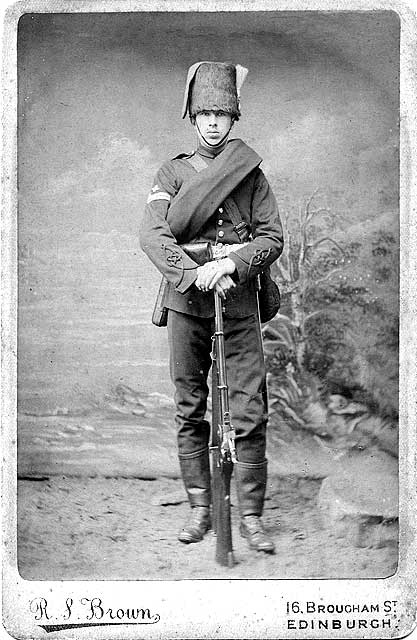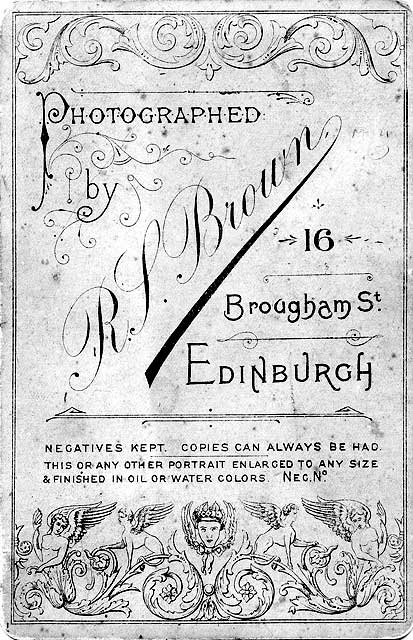|
Richard Stuart Brown |
Cabinet Print
Soldier from a Volunteer Unit
© Mark Cain, Minnesota, USA
I like the decoration along the bottom!
© Mark Cain, Minnesota, USA
|
Richard Stuart Brown |
|
Studios Richard Stuart Brown had studios in Edinburgh. - 1881 to 1883: at 14 Brougham Street - 1884 to 1885: at 1 Brougham Street - 1885 to 1928: at 16 Brougham Street The cabinet print above has the address, 16 Brougham Street, so probably dates from around 1855 to 1900. (Relatively few photos were produced in cabinet print format after about 1900.) |
|
Cabinet Print Thank you to Mark Cain for allowing me to reproduce this photo. Mark tells me that he has had an interest in Victorian military history since he was a boy in Canada, and that he collects photos of military subjects, swords, and uniforms. He has investigated the subject of this photo and has written: 1. Date of the Photo "I'm surprised to learn that Brown operated at this address only as early as 1885, as the uniform and equipment of the soldier led me to think it was from an earlier date. With this new information, I now suspect that the subject may be from a volunteer unit, as they were often equipped with weapons that became obsolete once new stores were issued." Mark Cain, Minnesota, USA: July 21, 2009 2. Volunteer Unit? "As I mentioned, I originally thought the photo was from about 1865-1875 as I think thatís a Snider Enfield Mk2, two-band rifle that the subject is holding. To my knowledge, these rifles were introduced in the early 1860s and were long obsolete by 1885, so they quite possibly were handed-down to volunteer units. I'll be posting the photo to a couple of military interest forums and might soon have a more concrete answer from people more expert than me. As for other distinguishing features, the subject is wearing a busby with a white hackle and light-colored bag (light blue?), a haversack on his left hip, and, on his right hip, a two-piece case that appears to have a split half-way between its ends. It looks as if the two ends of the case would be pulled directly apart from each other to let the soldier get at whatever it contains. I can only see the edge of the bayonet scabbard, but it looks like it would run about 23í-24Ē long overall. It is a consistent shape throughout its length, so it probably isnít the í53 'yataghan' sword bayonet."' Mark Cain, Minnesota, USA: July 21, 2009 3. Volunteer Artillery Unit "The current consensus is that the solider is of a volunteer artillery unit. I have leads on a few such units that were in Edinburgh in the mid-1880s and will continue to pursue them." Mark Cain, Minnesota, USA: July 23, 2009 4. 1st City of Edinburgh Royal Garrison Artillery Volunteers "Having found a digitized copy of 'Records of the Scottish Volunteer Force 1859-1908' by Major-General J' M. GRIERSON, C.V.O., C.B., C.M.G., I can say with some degree of confidence that this corporal is from the 1st City of Edinburgh Royal Garrison Artillery Volunteers. This is because the photo, taken in 1885 or later, shows the man wearing the busby which had been replaced four years earlier in all Scottish artillery volunteer units, except the 1st City of Edinburgh Royal Garrison Artillery Volunteers, per the extract below: 'As a head-dress, the busby of the Royal Artillery was universally adopted in the 'early sixties', and this was replaced in 1880-81 by the helmet, at first worn with a spike and afterwards with a ball. At the 'Coming of Age Review' in 1881, the 1st Edinburgh (City) and the 1st Renfrew and Dumbarton Artillery were the only corps which still wore the busby. The latter gave it up shortly afterwards, and the former was the only corps in Scotland which, till 1908, wore the headdress it assumed on its first formation.' QED. Riddle solved." Mark Cain, Minnesota, USA: July 24, 2009 |
Click here to select other photographers |
Richard Stuart Brown |

